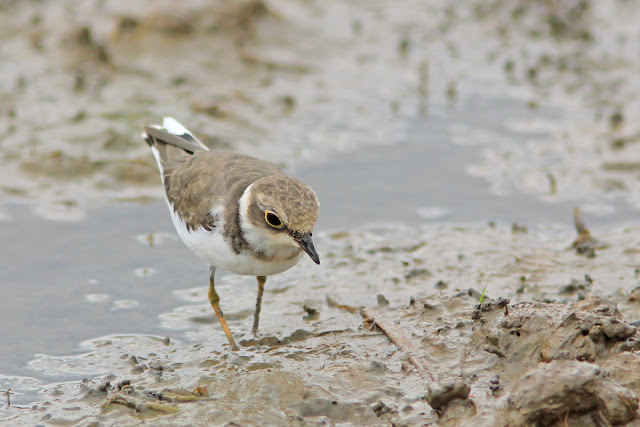Hi all, it's been a long time since my last post! I'm now back in Thailand and getting ready to move to Germany in October. Still have totally no idea how it's gonna be like over there. I'll sure miss Japanese birds. Anyway, it's been raining a lot recently and some migrants have already made their ways here. Yesterday, I found a flock of 10+ Little Ringed Plovers feeding just by the roadside near my hometown. Most of them were moulting into non-breeding plumage. But interestingly, I noticed that there was one bird in breeding plumage and apparently it was the resident race 'C. d. jerdoni'.
 |
| Male C. d. jerdoni in breeding plumage |
 |
| Note its thin black breast band |
 |
| The breast band looks especially thin when the bird looks down. |
The male bird seemed to have recently moulted into breeding plumage judging from the pale fringes to its upperparts feathers. I checked some of my older images of this race and found that by early March, these fringes would be gone and the feathers would be heavily worn, so the moulting period is much different from the migrating race 'C. d. curonicus' which breeds in northern hemisphere including Japan.
 |
| Most possibly C. d. jerdoni in non-breeding(?) plumage |
 |
| Note the fine bill, short-necked, rounded-head look |
 |
With a non-breeding C. d. curonicus in the background;
See the difference in shape and size? |
 |
| Again, the short-necked, rounded-head and fine short bill look |
In breeding plumage, it is not difficult to tell jerdoni apart from curonicus, as the black breast band is much thinner as well as the black bands on forehead and face. C. d. jerdoni also usually has larger pink spot at bill base. However, things get more complicated in non-breeding and juvenal plumage. I later noticed that 2 other birds in the group, one was in non-breeding and another in juvenal plumage, looked slightly different from others by showing some jerdoni characteristics. I believe the individual above is a non-breeding or probably first-summer jerdoni. I'm still not confident in ageing waders, so please correct me if I'm wrong.
 |
| Probably juvenile C. d. jerdoni |
 |
| With its prey |
 |
| Faint sandy-brown breast band |
 |
| It seemed to have remarkably long tail. |
 |
| C. d. jerdoni in breeding plumage in the centre, a non-breeding(?) on the right and C. d. curonicus on the left |
These 2 birds above was noticeably smaller and lighter-built than other curonicus that were feeding nearby. They also showed the typical short-necked, rounded-head and fine short bill look which I've always observed in breeding plumaged C. d. jerdoni. Apart from shape and plumage, these 3 birds also differed in feeding behaviour. They were more active, constantly moving almost without any pause. Other typical curonicus were noticeably slower and would pause longer while feeding. If these 3 birds are indeed jerdoni, it would be my first time seeing and photographing this race in non-breeding and juvenal plumage.
For comparisons, below are photos of C. d. curonicus that were feeding in the same area in various plumage and moult stage.
 |
| C. d. curonicus moulting into non-breeding plumage |
 |
| Note the heavier-built, slightly longer bill and shorter tail |
 |
| This individual has relatively thin breast band |
 |
| But the shape fits curonicus more in my opinion |
 |
| Showing the moult and wear |
 |
| This one is almost in full non-breeding plumage; note its long bill |
 |
| Yet another individual in non-breeding plumage |
 |
| This one is interesting because it was the only one in nice juvenile plumage. |
 |
| Look at that breast band, that's huge! |






































Wonderful observations and superb photography, Ayuwat. These little guys look really cool when observed closely. All the best with your travels. You, too, have a wader's spirit.
ReplyDeleteThanks, Russell! And you definitely have a wader's spirit too!
DeleteGreat stuff Ayuwat! It will take me a few reads to really digest all the insights you have gathered here, but what a great resource! So far, I don't think we have ever recorded a 'jerdoni' here, although there are populations to both the north and the south-east!
ReplyDeleteThanks, Dave! It would be interesting to know how far south this race can go. I know that there's a population breeding in western Thailand as well (Ratchaburi province), so it might be possible for Penang too.
Delete